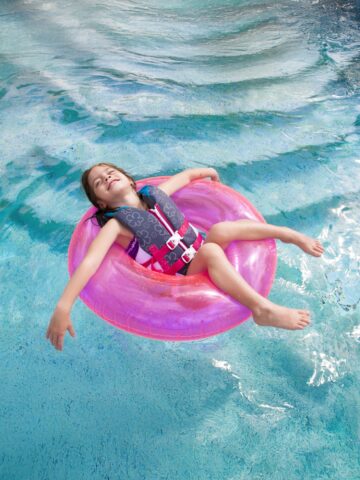- Chest tightness or pain
- Shortness of breath
- Wheezing
- Coughing
- Burning or stinging of the nose, throat and eyes
- Dizziness or lightheadedness
How can parents protect kids from the harmful health effects of fire and smoke?
- Evacuate the area if recommended by authorities.
- Prepare an emergency kit for your family (scroll below to view a list of recommended items you can include in an evacuation list).
- Stay indoors and minimize smoke exposure. Close all windows and doors.
- When driving, keep windows and vents closed. Turn the air-conditioning to re-circulate.
- Avoid sports practices, games or extreme exertion if the air quality is poor.
- Do NOT give your child a mask to filter contaminants, since masks do not work when not fitted correctly. Smaller sized masks may appear to fit a child’s face, but no manufacturers recommend their use for children.
- Increase water intake to avoid dehydration, which can happen quicker when breathing is compromised.
- Continue to minimize exposure to other sources of air pollutants such as cigarette smoke, smoke from wood or coal-burning furnaces, or smoke from a barbecue, as the combined effect of these smoke sources can have a greater impact on your child and family than the fire alone.
- Children with chronic respiratory problems, such as asthma, are at increased risk. Children at increased risk should remain in a clean-air environment, and be kept indoors until air quality improves. Administer any protective medications to your child as directed by your provider. They should be monitored closely for signs or symptoms of harmful health effects. If they are showing these symptoms and their usual medications cannot bring them under control, a visit with t heir healthcare provider should be completed. This can be a telehealth appointment conducted from home, or an in-person visit at your doctor’s office.

Parents should be mindful of the signs and symptoms of respiratory distress, says Dr. Charles Golden, vice president and executive medical director of CHOC’s Primary Care Network.
What are the warning signs of respiratory distress?
- Rapid breathing
- Use of accessory muscles (the muscles in the chest, rib cage and neck) become noticeable with each breath
- Fatigue, lack of energy, and increase in sleepiness in addition to the above symptoms
- Flaring of the nostrils or grunting with each breath
- Bluish/purplish discoloration of the lips, tongue and inner mouth in combination with the above symptom
If your child has these symptoms, seek urgent medical attention despite the risks of travel and outdoor air exposure. If these symptoms are severe, call 911.
Prepare an emergency kit for your family
In addition to the safety measures above, it’s important for families to be ready in case an evaluation or evacuation is required. Having an emergency kit prepared for everyone ensures that you are equipped to handle unexpected situations, particularly in the event that you need to seek medical attention or evacuate quickly.
Here’s a list of essential items to include in your family’s emergency kit, as recommended by CHOC expert Chris Riccardi:
Essentials for everyone:
- Documents:
- Identification (passports, IDs, birth certificates)
- Insurance policies (home, health, car)
- Medical records and prescriptions
- Emergency contacts list (hard copy)
- Copies of important documents in a waterproof folder
- Store records on a flash drive or external hard drive that can be taken with you
- Food and water:
- Non-perishable foods (granola bars, canned food with pull-tab lids, etc.)
- Baby formula (powder or ready-to-feed) and baby food pouches
- Water: At least 1 gallon per person per day (1/2 gallon for consumption/ 1/2 gallon for hygiene)
- Bottles for formula or water
- Manual can opener
- Clothing and blankets:
- Weather-appropriate clothes for each family member (layers for varying conditions)
- Infant onesies, sleepers, and socks
- Sturdy shoes and hats
- Warm blankets and a portable baby blanket or swaddle
- First aid and hygiene:
- First aid kit
- Medications for each family member
- Diapers and wipes for the infant
- Pull-ups or spare underwear for the young child
- Feminine hygiene products
- Soap, hand sanitizer, and tissues
- Toothbrushes, toothpaste, and a hairbrush
- Plastic bags for waste disposal
- Lighting and communication:
- Flashlights and extra batteries
- Battery-powered or hand-crank radio
- Fully charged power banks for devices
- Phone chargers and adapters
- Glow sticks
- Your car will/can serve as a power supply to charge phones/devices
- Safety and tools:
- Multi-tool or Swiss Army knife
- Duct tape
- Matches or a lighter in a waterproof container
- Dust masks or N95 masks for smoke protection
- Emergency whistle
- Cash and supplies:
- Small denominations of cash and coins
- Local maps
Infant-specific needs:
- Feeding supplies:
- Extra bottles and nipples
- Formula dispenser (if needed)
- Comfort items:
- Pacifiers
- Favorite toy or lovey
- Small teether or rattle
- Carrying and resting:
- Baby carrier or sling
- Portable crib or bassinet (if possible)
Young child-specific needs:
- Entertainment and comfort:
- Small toys, books, or activity kits
- Comfort item like a stuffed animal or blanket
- Snacks:
- Easy-to-eat, non-messy snacks like crackers, pouches, or dried fruit
- Clothing and shoes:
- Extra outfits and sturdy shoes
Fire-specific supplies:
- Fire-resistant blankets or jackets
- Eye drops for irritation
- Maps with evacuation routes
- Smoke-filtering masks for children (check sizing)
Optional but useful:
- Pet supplies (if applicable):
- Pet food, bowls, leash, and carrier
- Comfort and sleep:
- Travel pillows or inflatable mattress
- Earplugs (if sensitive to noise)
Keep these items in a portable, easily accessible bag or backpack. Regularly update and check the kit to ensure food, batteries, and other items are fresh and functional.
Printable checklist: Disaster Preparedness Emergency Packing Checklist for Families





